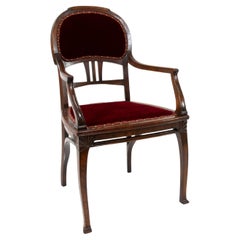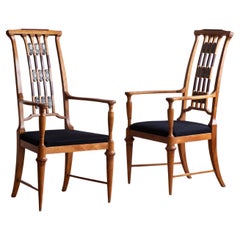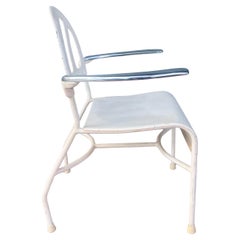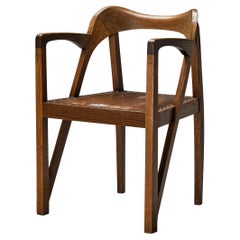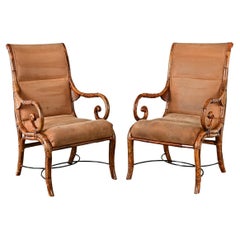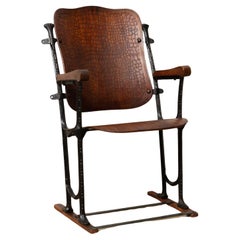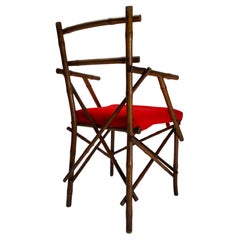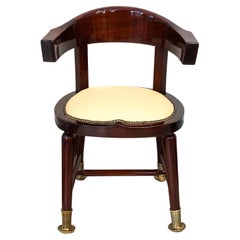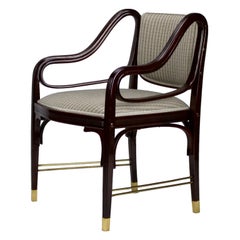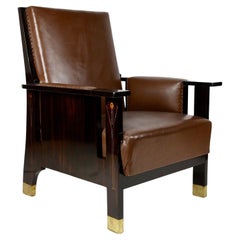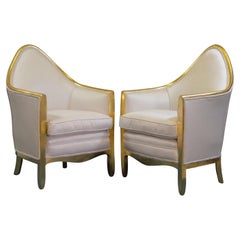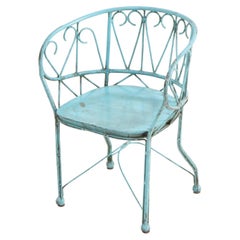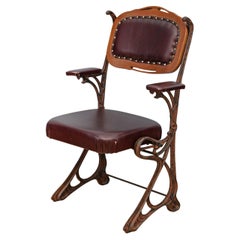Art Nouveau Metal Armchairs
Antique Early 1900s German Art Nouveau Armchairs
Brass
Early 20th Century Danish Art Nouveau Armchairs
Pewter
20th Century French Art Nouveau Armchairs
Metal, Chrome
Antique Early 1900s European Jugendstil Armchairs
Brass
20th Century French Art Nouveau Armchairs
Iron
Vintage 1930s Spanish Art Nouveau Armchairs
Iron
Vintage 1910s Italian Art Nouveau Armchairs
Metal
Antique Early 1900s Austrian Art Nouveau Armchairs
Brass
Antique Early 19th Century Austrian Art Nouveau Armchairs
Brass
Early 20th Century Austrian Art Nouveau Armchairs
Brass
Early 20th Century French Art Nouveau Armchairs
Gold Leaf
Antique Early 1900s French Art Nouveau Armchairs
Wrought Iron
Early 20th Century Austrian Art Nouveau Armchairs
Bronze
Antique Early 1900s European Art Nouveau Armchairs
Bronze
Antique Early 1900s Austrian Art Nouveau Armchairs
Brass
Early 20th Century Belgian Art Nouveau Armchairs
Brass, Iron
Antique Late 19th Century German Jugendstil Armchairs
Brass
Early 20th Century Belgian Art Nouveau Armchairs
Brass, Iron
Early 20th Century French Art Nouveau Rocking Chairs
Copper
Recent Sales
Antique Early 1900s French Art Nouveau Armchairs
Iron
20th Century European Art Nouveau Armchairs
Brass
Antique Late 19th Century Spanish Art Nouveau Armchairs
Brass
Early 20th Century Unknown Art Nouveau Patio and Garden Furniture
Iron
Antique 1890s Austrian Art Nouveau Armchairs
Iron
20th Century Austrian Jugendstil Armchairs
Brass
Antique Early 1900s Austrian Art Nouveau Armchairs
Brass
Early 20th Century Italian Art Nouveau Armchairs
Copper, Pewter
Vintage 1910s Finnish Art Nouveau Armchairs
Copper
Early 20th Century Austrian Art Nouveau Armchairs
Brass
Antique Early 1900s Austrian Art Nouveau Armchairs
Metal
Antique Early 1900s Austrian Art Nouveau Armchairs
Brass
Early 20th Century Austrian Art Nouveau Armchairs
Brass
Early 20th Century Belgian Art Nouveau Armchairs
Brass
Vintage 1920s Austrian Art Nouveau Armchairs
Brass
Antique Late 19th Century British Art Nouveau Rocking Chairs
Brass, Steel
2010s Italian Art Nouveau Armchairs
Metal
2010s Italian Art Nouveau Armchairs
Metal
Early 20th Century English Art Nouveau Chairs
Brass
Antique Late 19th Century Italian Art Nouveau Armchairs
Brass
Antique Early 1900s Italian Art Nouveau Armchairs
Copper
Mid-20th Century American Art Nouveau Armchairs
Aluminum
Antique Early 1900s English Art Nouveau Swivel Chairs
Brass
Early 20th Century Austrian Art Nouveau Armchairs
Bronze
Antique Early 1900s Belgian Art Nouveau Armchairs
Brass, Wrought Iron
Antique Early 1900s Italian Art Nouveau Armchairs
Brass
Antique Early 1900s Italian Art Nouveau Armchairs
Copper
Antique Early 1900s Italian Art Nouveau Armchairs
Iron
Early 20th Century German Art Nouveau Armchairs
Metal
Antique Early 1900s German Art Nouveau Armchairs
Other
Antique Early 1900s German Art Nouveau Armchairs
Other
Vintage 1910s French Art Nouveau Armchairs
Iron
Antique Early 1900s Austrian Jugendstil Armchairs
Brass
Antique Early 1900s Italian Art Nouveau Armchairs
Brass
Early 20th Century Italian Art Nouveau Armchairs
Brass, Copper
Early 20th Century Austrian Art Nouveau Armchairs
Brass
People Also Browsed
Mid-20th Century German Armchairs
Steel
Vintage 1940s Swedish Scandinavian Modern Cabinets
Pine
21st Century and Contemporary American Bohemian Chandeliers and Pendants
Brass
21st Century and Contemporary Italian Modern Sofas
Metal
Early 20th Century Japanese Taisho Tables
Wood
Vintage 1960s Italian Post-Modern Vanities
Metal, Brass
1990s Italian Mid-Century Modern Chandeliers and Pendants
Brass
Vintage 1950s Swedish Scandinavian Modern Sofas
Wool, Cotton, Beech
Early 20th Century Swedish Art Deco Animal Sculptures
Bronze
Vintage 1940s Italian Art Deco Daybeds
Sheepskin, Walnut
Early 20th Century French Art Deco Center Tables
Brass
Vintage 1950s Italian Mid-Century Modern Tables
Brass
Vintage 1970s European Brutalist Coffee and Cocktail Tables
Resin
Vintage 1960s European Mid-Century Modern Side Tables
Oak
2010s French Modern Chairs
Fabric, Satin, Oak
Vintage 1970s Italian Post-Modern Wardrobes and Armoires
Wood
Art Nouveau Metal Armchairs For Sale on 1stDibs
How Much are Art Nouveau Metal Armchairs?
A Close Look at Art Nouveau Furniture
In its sinuous lines and flamboyant curves inspired by the natural world, antique Art Nouveau furniture reflects a desire for freedom from the stuffy social and artistic strictures of the Victorian era. The Art Nouveau movement developed in the decorative arts in France and Britain in the early 1880s and quickly became a dominant aesthetic style in Western Europe and the United States.
ORIGINS OF ART NOUVEAU FURNITURE DESIGN
- Emerged during the late 19th century
- Popularity of this modernizing style declined in the early 20th century
- Originated in France and Britain but variants materialized elsewhere
- Informed by Rococo, Pre-Raphaelite art, Japanese art (and Japonisme), Arts and Crafts; influenced modernism, Bauhaus
CHARACTERISTICS OF ART NOUVEAU FURNITURE DESIGN
- Sinuous, organic and flowing lines
- Forms that mimic flowers and plant life
- Decorative inlays and ornate carvings of natural-world motifs such as insects and animals
- Use of hardwoods such as oak, mahogany and rosewood
ART NOUVEAU FURNITURE DESIGNERS TO KNOW
ANTIQUE ART NOUVEAU FURNITURE ON 1STDIBS
Art Nouveau — which spanned furniture, architecture, jewelry and graphic design — can be easily identified by its lush, flowing forms suggested by flowers and plants, as well as the lissome tendrils of sea life. Although Art Deco and Art Nouveau were both in the forefront of turn-of-the-20th-century design, they are very different styles — Art Deco is marked by bold, geometric shapes while Art Nouveau incorporates dreamlike, floral motifs. The latter’s signature motif is the "whiplash" curve — a deep, narrow, dynamic parabola that appears as an element in everything from chair arms to cabinetry and mirror frames.
The visual vocabulary of Art Nouveau was particularly influenced by the soft colors and abstract images of nature seen in Japanese art prints, which arrived in large numbers in the West after open trade was forced upon Japan in the 1860s. Impressionist artists were moved by the artistic tradition of Japanese woodblock printmaking, and Japonisme — a term used to describe the appetite for Japanese art and culture in Europe at the time — greatly informed Art Nouveau.
The Art Nouveau style quickly reached a wide audience in Europe via advertising posters, book covers, illustrations and other work by such artists as Aubrey Beardsley, Henri de Toulouse-Lautrec and Alphonse Mucha. While all Art Nouveau designs share common formal elements, different countries and regions produced their own variants.
In Scotland, the architect Charles Rennie Mackintosh developed a singular, restrained look based on scale rather than ornament; a style best known from his narrow chairs with exceedingly tall backs, designed for Glasgow tea rooms. Meanwhile in France, Hector Guimard — whose iconic 1896 entry arches for the Paris Metro are still in use — and Louis Majorelle produced chairs, desks, bed frames and cabinets with sweeping lines and rich veneers.
The Art Nouveau movement was known as Jugendstil ("Youth Style") in Germany, and in Austria the designers of the Vienna Secession group — notably Koloman Moser, Josef Hoffmann and Joseph Maria Olbrich — produced a relatively austere iteration of the Art Nouveau style, which mixed curving and geometric elements.
Art Nouveau revitalized all of the applied arts. Ceramists such as Ernest Chaplet and Edmond Lachenal created new forms covered in novel and rediscovered glazes that produced thick, foam-like finishes. Bold vases, bowls and lighting designs in acid-etched and marquetry cameo glass by Émile Gallé and the Daum Freres appeared in France, while in New York the glass workshop-cum-laboratory of Louis Comfort Tiffany — the core of what eventually became a multimedia decorative-arts manufactory called Tiffany Studios — brought out buoyant pieces in opalescent favrile glass.
Jewelry design was revolutionized, as settings, for the first time, were emphasized as much as, or more than, gemstones. A favorite Art Nouveau jewelry motif was insects (think of Tiffany, in his famed Dragonflies glass lampshade).
Like a mayfly, Art Nouveau was short-lived. The sensuous, languorous style fell out of favor early in the 20th century, deemed perhaps too light and insubstantial for European tastes in the aftermath of World War I. But as the designs on 1stDibs demonstrate, Art Nouveau retains its power to fascinate and seduce.
There are ways to tastefully integrate a touch of Art Nouveau into even the most modern interior — browse an extraordinary collection of original antique Art Nouveau furniture on 1stDibs, which includes decorative objects, seating, tables, garden elements and more.
Finding the Right Armchairs for You
Armchairs have run the gamut from prestige to ease and everything in between, and everyone has an antique or vintage armchair that they love.
Long before industrial mass production democratized seating, armchairs conveyed status and power.
In ancient Egypt, the commoners took stools, while in early Greece, ceremonial chairs of carved marble were designated for nobility. But the high-backed early thrones of yore, elevated and ornate, were merely grandiose iterations of today’s armchairs.
Modern-day armchairs, built with functionality and comfort in mind, are now central to tasks throughout your home. Formal dining armchairs support your guests at a table for a cheery feast, a good drafting chair with a deep seat is parked in front of an easel where you create art and, elsewhere, an ergonomic wonder of sorts positions you at the desk for your 9 to 5.
When placed under just the right lamp where you can lounge comfortably, both elbows resting on the padded supports on each side of you, an upholstered armchair — or a rattan armchair for your light-suffused sunroom — can be the sanctuary where you’ll read for hours.
If you’re in the mood for company, your velvet chesterfield armchair is a place to relax and be part of the conversation that swirls around you. Maybe the dialogue is about the beloved Papa Bear chair, a mid-century modern masterpiece from Danish carpenter and furniture maker Hans Wegner, and the wingback’s strong association with the concept of cozying up by the fireplace, which we can trace back to its origins in 1600s-era England, when the seat’s distinctive arm protrusions protected the sitter from the heat of the period’s large fireplaces.
If the fireside armchair chat involves spirited comparisons, your companions will likely probe the merits of antique and vintage armchairs such as Queen Anne armchairs, Victorian armchairs or even Louis XVI armchairs, as well as the pros and cons of restoration versus conservation.
Everyone seems to have a favorite armchair and most people will be all too willing to talk about their beloved design. Whether that’s the unique Favela chair by Brazilian sibling furniture designers Fernando and Humberto Campana, who repurposed everyday objects to provocative effect; or Marcel Breuer’s futuristic tubular metal Wassily lounge chair; the functionality-first LC series from Charlotte Perriand, Le Corbusier and Pierre Jeanneret; or the Eames lounge chair of the mid-1950s created by Charles and Ray Eames, there is an iconic armchair for everyone and every purpose. Find yours on 1stDibs right now.
